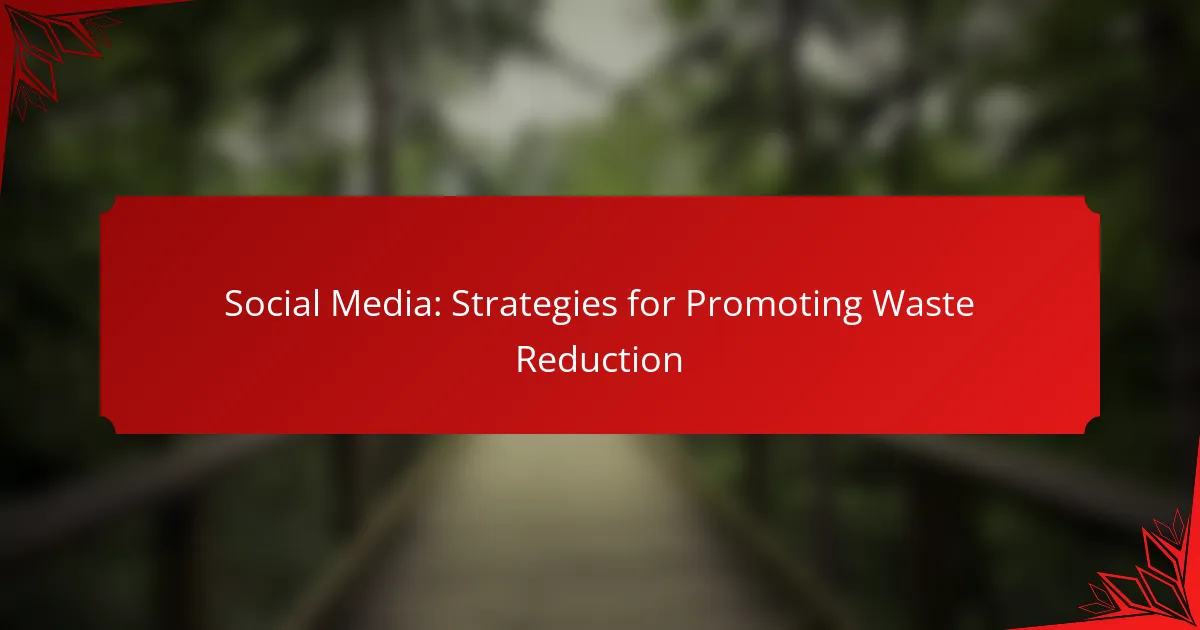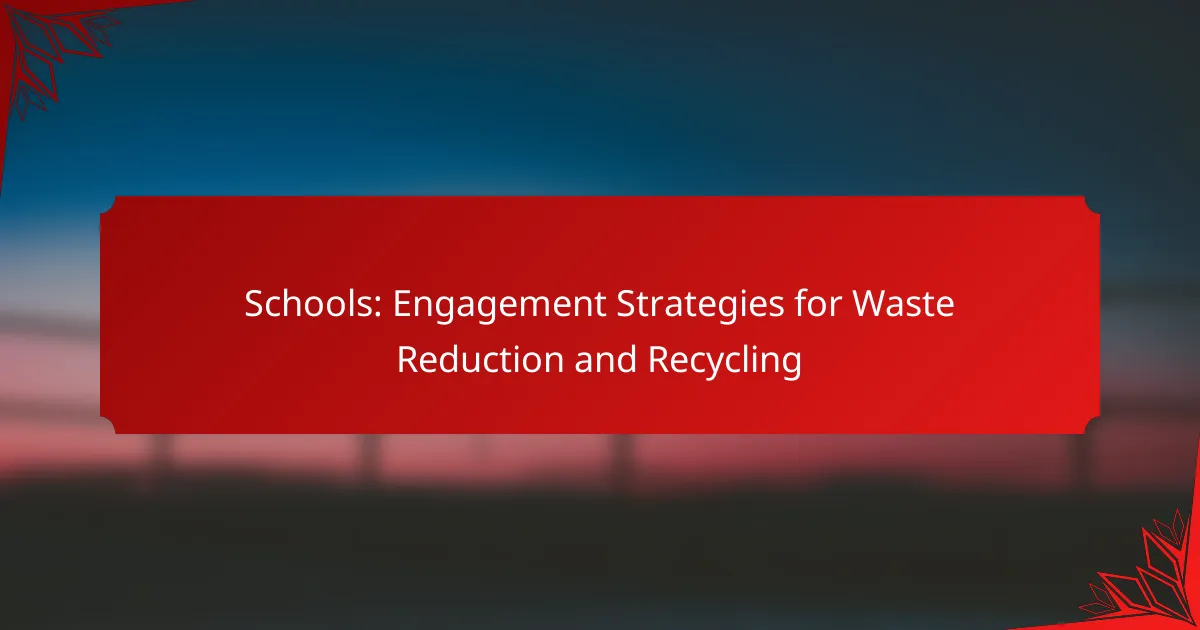Social media serves as a powerful tool for promoting waste reduction by raising community awareness and encouraging sustainable practices. By utilizing platforms like Facebook, Instagram, and Twitter, organizations can effectively share messages about recycling and composting, while also engaging residents in impactful ways. Implementing strategies such as storytelling and social media contests can further enhance participation and foster a sense of community commitment to reducing waste.

How can social media promote waste reduction in urban areas?
Social media can effectively promote waste reduction in urban areas by fostering community awareness and encouraging sustainable practices. Platforms like Facebook, Instagram, and Twitter can amplify messages about recycling, composting, and reducing single-use plastics, engaging residents in meaningful ways.
Community engagement campaigns
Community engagement campaigns leverage social media to connect residents with local waste reduction initiatives. These campaigns can include contests, events, and challenges that encourage participation, such as neighborhood clean-ups or recycling drives. By sharing success stories and progress updates online, communities can build momentum and inspire others to join.
To maximize impact, use local hashtags and tag relevant organizations to increase visibility. Engaging visuals and videos can also enhance participation and shareability.
Influencer partnerships
Partnering with local influencers can amplify waste reduction messages to a broader audience. Influencers can showcase sustainable practices, such as zero-waste shopping or DIY recycling projects, making these concepts more relatable and appealing. Their established trust with followers can drive significant engagement and inspire action.
Choose influencers who align with your values and have a genuine interest in sustainability. Authenticity is key; audiences respond better to influencers who practice what they preach.
Hashtag challenges
Hashtag challenges encourage users to share their waste reduction efforts using a specific tag, creating a sense of community and accountability. For example, a challenge could prompt participants to post daily photos of their recycling habits or meals made from leftovers. This not only raises awareness but also fosters a culture of sustainability.
Promote the challenge across multiple platforms and offer incentives, such as prizes or recognition, to increase participation. Engaging visuals and clear instructions can help participants understand how to join in.
Educational content sharing
Sharing educational content on social media can inform urban residents about waste reduction strategies. This can include infographics, videos, and articles that explain the importance of recycling, composting, and reducing waste. Providing practical tips and local resources can empower individuals to take action.
Consider hosting live Q&A sessions or webinars to address common questions and concerns about waste management. Collaborating with local experts can enhance credibility and provide valuable insights.
Local recycling initiatives
Highlighting local recycling initiatives on social media can drive participation and awareness. Share information about recycling drop-off locations, collection schedules, and accepted materials. Engaging posts can include success stories from local businesses or residents who have made significant strides in reducing waste.
Encourage followers to share their recycling experiences and tips, creating a community of support. Regular updates about local initiatives can keep the conversation going and motivate ongoing participation in waste reduction efforts.

What are effective strategies for businesses?
Effective strategies for businesses to promote waste reduction include engaging storytelling, customer participation, and leveraging social media contests. These approaches not only raise awareness but also foster community involvement and brand loyalty.
Brand storytelling
Brand storytelling involves sharing narratives that highlight a company’s commitment to waste reduction. This can be achieved through blog posts, videos, or social media updates that showcase sustainable practices and the positive impact on the environment.
For example, a company might share the journey of how they transitioned to eco-friendly packaging, emphasizing the benefits of this change. Authentic stories resonate with customers and can enhance brand loyalty.
Customer participation programs
Customer participation programs encourage consumers to engage actively in waste reduction efforts. Businesses can create initiatives such as recycling challenges or rewards for returning used products, which not only motivate customers but also build a community around sustainability.
For instance, a retail store could offer discounts for customers who bring in reusable bags or containers. This not only reduces waste but also reinforces the brand’s commitment to environmental responsibility.
Promoting sustainable products
Promoting sustainable products is crucial for businesses aiming to reduce waste. Highlighting items made from recycled materials or those designed for longevity can attract environmentally conscious consumers.
Companies should ensure that their marketing materials clearly communicate the environmental benefits of these products. For example, labeling products with certifications like “organic” or “recyclable” can help customers make informed choices.
Social media contests
Social media contests can effectively engage audiences while promoting waste reduction. Businesses can encourage users to share their own waste reduction tips or showcase their sustainable practices for a chance to win prizes.
Contests not only increase brand visibility but also create a sense of community among participants. For example, a company might run a contest asking followers to post photos of their recycling efforts, using a specific hashtag to track entries.
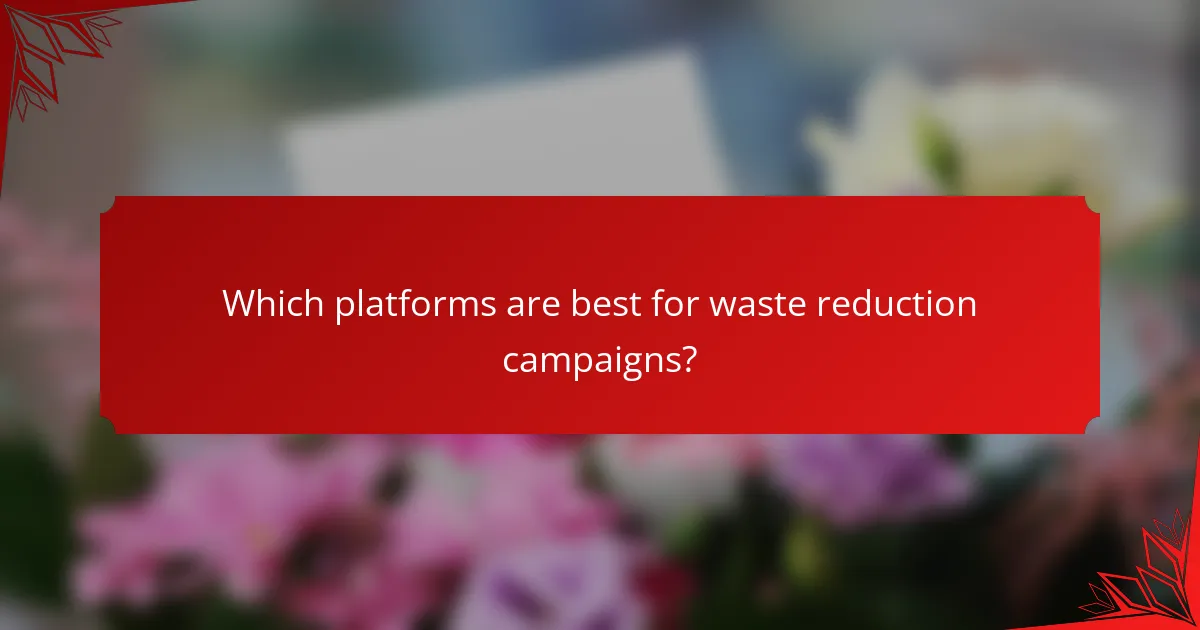
Which platforms are best for waste reduction campaigns?
Effective waste reduction campaigns thrive on platforms that enhance engagement and reach. The best platforms for promoting waste reduction include Instagram, Facebook, Twitter, and LinkedIn, each offering unique advantages for different aspects of campaign strategy.
Instagram for visual storytelling
Instagram excels at visual storytelling, making it ideal for showcasing waste reduction efforts through compelling images and videos. Brands can highlight before-and-after transformations, eco-friendly products, and community initiatives to inspire followers.
Using features like Stories and Reels can amplify engagement, allowing for quick tips on reducing waste or showcasing sustainable practices. Collaborating with influencers in the sustainability space can further extend reach and credibility.
Facebook for community building
Facebook is effective for building communities around waste reduction initiatives. Groups can be created to foster discussions, share resources, and organize local clean-up events, creating a sense of belonging among members.
Utilizing Facebook Events can help promote workshops or webinars focused on waste reduction strategies. Regular posts that encourage interaction, such as polls or challenges, can keep the community engaged and motivated.
Twitter for real-time updates
Twitter serves as a platform for real-time updates and quick information sharing about waste reduction efforts. It’s suitable for announcing events, sharing news related to sustainability, or engaging in conversations with followers and other organizations.
Using relevant hashtags can increase visibility and connect with broader conversations around waste reduction. Engaging with trending topics can also help draw attention to specific campaigns or initiatives.
LinkedIn for corporate responsibility
LinkedIn is the go-to platform for promoting corporate responsibility related to waste reduction. Companies can share their sustainability goals, achievements, and partnerships with other organizations committed to reducing waste.
Publishing articles or posts that highlight case studies or best practices can position a company as a leader in sustainability. Engaging with industry professionals can also foster collaborations and drive collective action toward waste reduction.
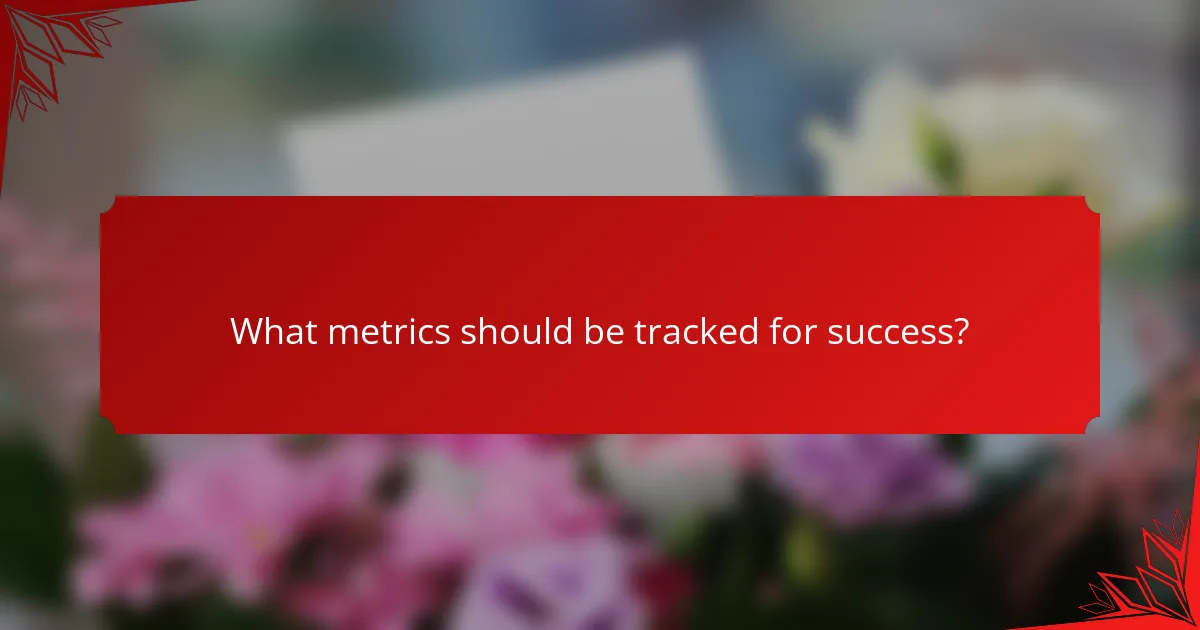
What metrics should be tracked for success?
To effectively promote waste reduction on social media, tracking key metrics is essential for evaluating success. Focus on engagement rates, reach and impressions, conversion rates, and community feedback to understand the impact of your efforts.
Engagement rates
Engagement rates measure how actively users interact with your content, including likes, shares, comments, and saves. A higher engagement rate indicates that your audience finds your waste reduction messages compelling. Aim for engagement rates above 1-3% as a benchmark for effective content.
To boost engagement, create interactive posts such as polls or challenges that encourage users to share their waste reduction practices. Monitor which types of content generate the most interaction to refine your strategy.
Reach and impressions
Reach refers to the number of unique users who see your content, while impressions indicate how many times your content is displayed, regardless of clicks. Tracking these metrics helps gauge the visibility of your waste reduction campaigns. Aim for a steady increase in both metrics over time.
Utilize targeted advertising to enhance reach, especially in local communities. Analyzing the demographics of your audience can help tailor content that resonates better with specific groups, increasing overall impressions.
Conversion rates
Conversion rates measure the percentage of users who take a desired action after engaging with your content, such as signing up for a newsletter or participating in a recycling program. A higher conversion rate indicates effective messaging and audience alignment with your waste reduction goals.
To improve conversion rates, include clear calls-to-action in your posts. Test different approaches, such as offering incentives for participation, to determine what resonates best with your audience.
Community feedback
Community feedback provides qualitative insights into how your audience perceives your waste reduction initiatives. This can be gathered through comments, direct messages, or surveys. Actively listening to feedback allows you to adjust your strategies to better meet community needs.
Encourage feedback by asking open-ended questions in your posts or conducting polls. Regularly review this input to identify trends and areas for improvement, ensuring your campaigns remain relevant and impactful.
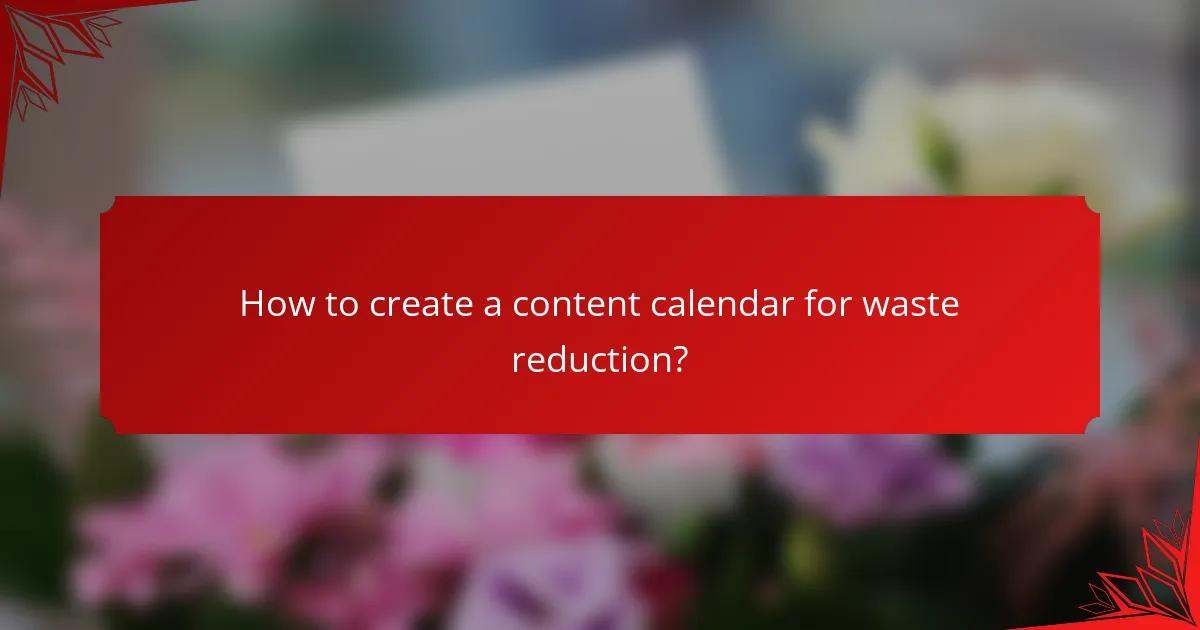
How to create a content calendar for waste reduction?
Creating a content calendar for waste reduction involves planning and organizing your social media posts to effectively promote sustainable practices. This structured approach helps ensure consistent messaging and engagement with your audience.
Identify key themes and goals
Start by determining the main themes related to waste reduction that resonate with your audience, such as recycling tips, composting, or reducing plastic use. Set specific goals for each theme, like increasing awareness or encouraging community participation in local clean-up events.
Choose your platforms
Select the social media platforms that best align with your target audience. For instance, Instagram and Facebook are effective for visual content, while Twitter can be used for quick tips and updates. Tailor your content to fit the unique characteristics of each platform.
Plan your content frequency
Decide how often you want to post about waste reduction. A good starting point is to aim for 2-3 posts per week, allowing for a mix of educational content, engaging visuals, and community stories. Adjust the frequency based on audience engagement and feedback.
Create a posting schedule
Develop a calendar that outlines what content will be posted on which days. This can be a simple spreadsheet or a dedicated content calendar tool. Include details like post type, platform, and any relevant hashtags or links to resources.
Monitor and adjust
Regularly review the performance of your posts to see what resonates with your audience. Use analytics tools to track engagement metrics such as likes, shares, and comments. Be prepared to adjust your content calendar based on what works best for promoting waste reduction.
